What Is Scope Creep? What It Means and How to Avoid It in 2025
Unfortunately, even the best project plans can change on a dime. Extra work, changing deadlines, poor communication and other issues can quickly make a project spiral out of control. If you don’t want your project to fall into disrepair, read this article to learn how to send scope creep packing.
Key Takeaways: What Is Scope Creep?
- Scope creep is when there’s uncontrolled growth in a project in terms of expanding due dates and budgets.
- Scope creep can be controlled if you take the time to plan your project properly and keep any scope changes well documented.
- The key to preventing scope creep is constant communication and having checks and balances in place.
Project managers spend large amounts of time designing project scopes that define what projects are and how they will be completed. A solid plan should ensure that projects will run without a hitch. However, even the best plans can balloon; for example, planning couldn’t stop Denver International Airport from being 16 months behind schedule and $2 billion over budget because of scope creep.
Scope creep is a problem that can jump up, land a sucker punch and ultimately prevent you handing over project deliverables on time. Below, we’ll explain project scope creep and tell you how it derails projects.
We’ll also mention some of the best project management software that can help get things under control and talk about what project managers can do to lead their teams to glory. Let’s dive in.
What Is Scope Creep in Project Management?
Scope creep is when your project’s original plan keeps changing and the amount of work that needs to be done keeps expanding. Now there’s extra expenses, a breakdown in communication and out-of-control deadlines. Scope creep, if left unchecked, can destroy a project.
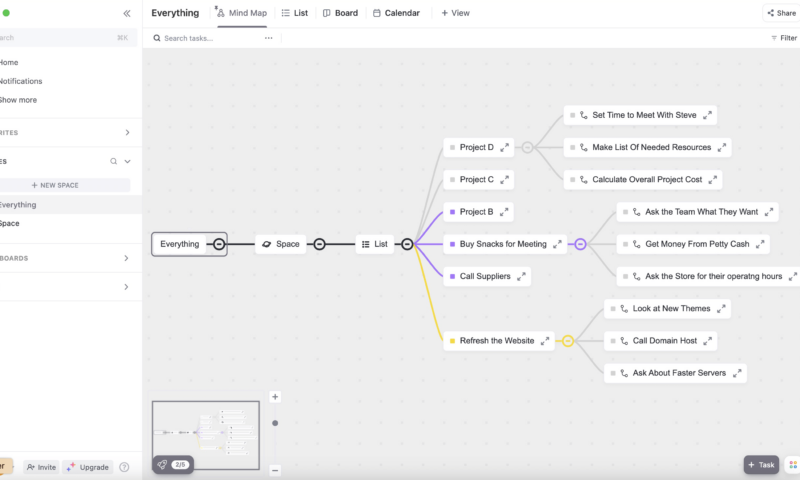
keep your project from becoming a victim of scope creep.
Project Scope & Scope Creep Definition
Before we go any further, let’s just take a minute to define what project scope and scope creep are.
Project scope is a plan that a project manager and key stakeholders create at the start of a project. Tasks, roles, expenses, resources and deadlines are all defined.
Scope creep is when the original plan is expanded upon after work has already begun — or, worse — is nearly complete.
This doesn’t sound terrible; after all, a few changes here and there can be accommodated. The problems arise when a project manager and stakeholders don’t discuss new tasks and deliverables, deadlines, expenses, resources and increased team workloads. Without proper communication, extra resources and additional planning, a project could fall into disarray.
Consequences of Scope Creep
As you have probably guessed by now, scope creep is something you want to avoid at all costs. Nothing good ever comes from it. Below, we will take a quick look at the negative effects of scope creep.
- Missed deadlines and delivery dates: Added requirements and deliverables that aren’t accounted for could cause missed deadlines and costly delays.
- Exceeding budgets: Extra work without further compensation will stretch your budget thin.
- Overworked project team: An overworked team will make more mistakes than usual, and morale will nosedive.
- Poor final results: Poorly planned work from an overworked team could lead to poor final results.
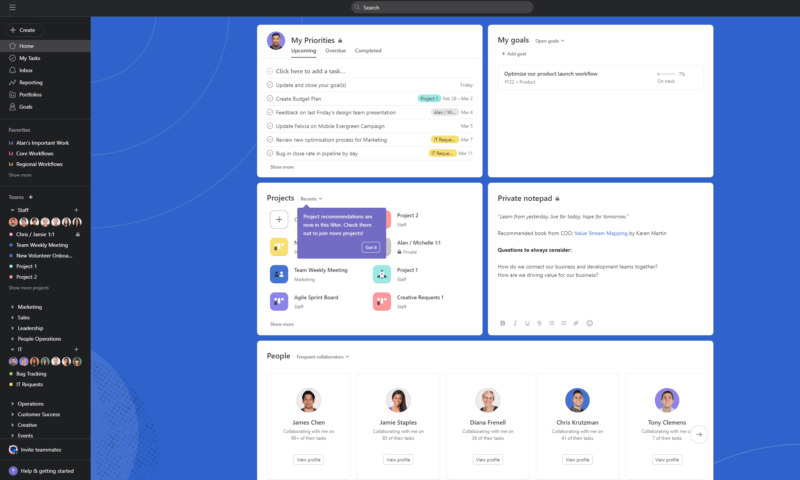
Of course, scope creep has many more consequences, including personal and organizational reputation hits, employee turnover, loss of income and total project failure.
The Five Most Common Causes of Scope Creep
Now that we know what a project scope and scope creep are, it’s time to look at the five most common causes of scope creep. If you’re a project manager, you’ll want to take notes here. If you notice any of these issues, you’ll want to nip them in the bud as soon as possible.
1. A Poor or Missing Project Scope
Every project needs a solid plan that includes a project timeline, project requirements, tasks, stages, budgets, a list of resources, deadlines and milestones, and a clear understanding of what the project deliverable is. Without a project blueprint, you’ll run into problems right out of the gate.
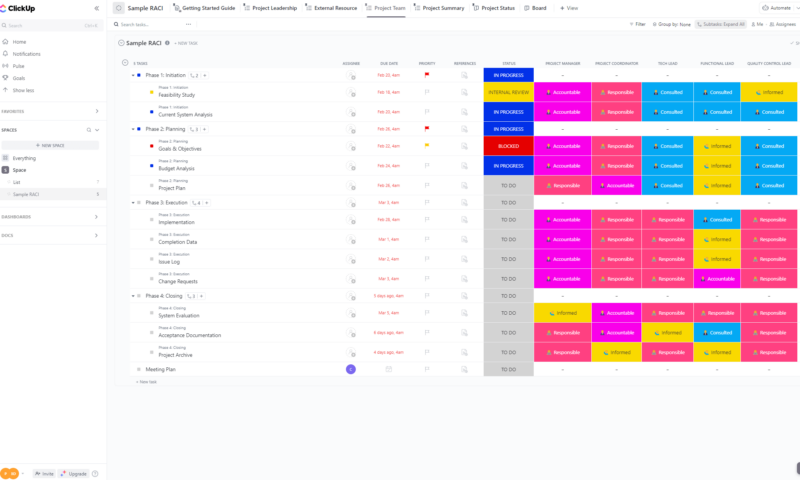
can help you define project roles before a project starts.
By defining a project’s scope, you’ll know who’s doing what, what’s expected and when, and what resources are available. Not planning for risks, challenges and potential changes will also lead to disaster: Do not skip this step. Once the project’s scope has been defined, ensure that everyone, including all project stakeholders, signs off on the plan.
2. Substandard Communication
Communication is key to getting good results in many areas of life, and project management is no exception. When communication between a project manager and their team, clients and stakeholders breaks down — or when communication is vague — problems will arise.
3. Additional Undocumented Work
When clients, stakeholders and even project managers add work to a project that hasn’t been officially documented or planned for, a project can derail, especially if extra tasks are added frequently. Ensure that every additional piece of work is run through the proper channels and is added to the project scope; otherwise, the project may falter.
4. Too Many Requests
Scope creep occurs when clients make change requests to an already-defined project schedule. It’s not uncommon for one or two requests to be made. However, when multiple changes are requested from numerous stakeholders who might not understand how big an undertaking a task may be, projects can fall behind schedule and run over budget.
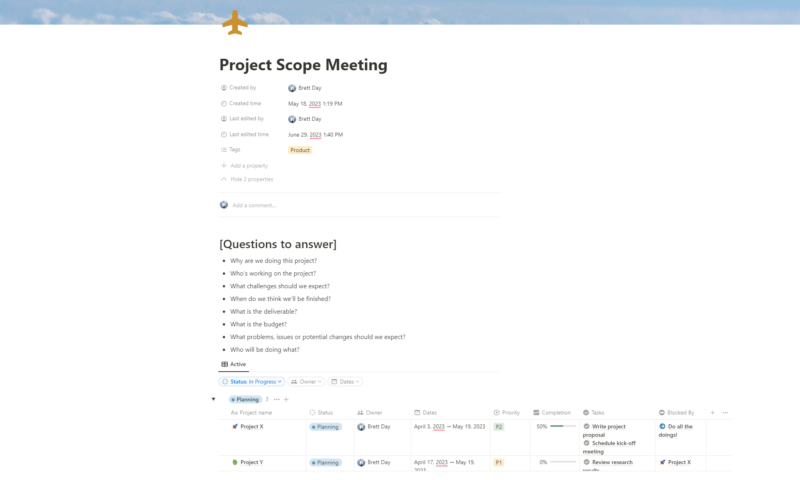
a project scope in real time with your team and clients.
5. Lack of Resources
If you accept too many unofficial requests as a project manager and don’t have a plan in place to deal with the extra work, you’ll be in trouble. Extra work requires additional team members, which can require extra equipment and incur more expenses. Pretty soon, if work issues like these are left unaddressed, you’ll likely end up understaffed, overworked and over budget.
How to Avoid Scope Creep
If your project is already underway and some cracks in the original project scope are beginning to appear, what can you do? Quite a lot, actually. Below, we’ll go over some steps that can help you manage scope creep.
Create a Project Scope
You can proactively prevent scope creep by creating a project scope before your project starts. Start by picking a piece of project management software that offers tools that suit multiple project management methodologies, like kanban and Scrum or PRINCE2 (check out our guide on what is PRINCE2 to find out more). Ensure the software also provides planning tools and robust collaboration features, like ClickUp does (here’s our ClickUp review).
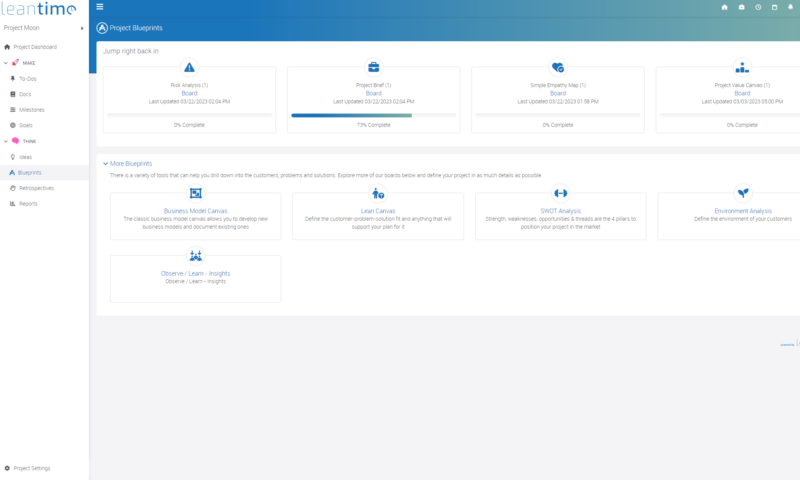
Next, discuss the project scope with your client and team. Agree upon the deliverables, budgets, tasks, deadlines, milestones and project phases. Use RACI charts to define roles and responsibilities. It would also be wise to create risk logs to plan for problems and requests that may arise. Leantime (here’s our Leantime review) is a robust platform that can help facilitate these measures.
Hold Regular Team and Stakeholder Meetings
Communication is critical when it comes to keeping a project on track. As a project manager, you must regularly meet with your team and stakeholders. It doesn’t matter if you use tools like Zoom or Microsoft Teams, hold chats on platforms like Slack (here’s our Slack review) or facilitate meetings face-to-face — like Scrum Masters. These retrospective meetings need to happen.

to hold meetings with your team and stakeholders.
During every meeting, cover every aspect of the project. Share with stakeholders how tasks are progressing, how much work team members have taken on, expenses, delays and any problems. If a change to the project scope is requested, ensure you have all project metrics and information at hand, so you can talk about the changes and their potential impact.
Document Requested Changes
One of the easiest ways to fight scope creep is to insist that every requested change happens officially. Too often, project managers take on additional tasks without documenting them. By accepting unofficial requests, the original project scope will quickly be out of alignment.
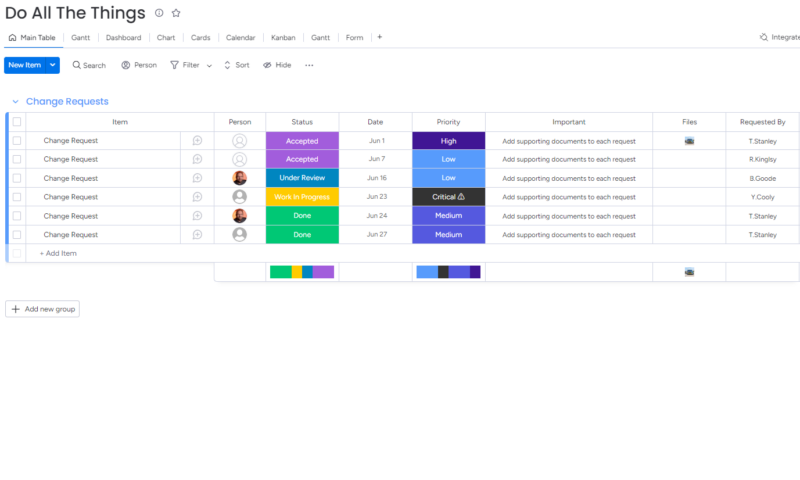
to create simple yet effective change request forms.
When a change is requested and approved, you need to sit down with your client to update the project scope. If you fail to take into account additional tasks or deliverables and then continue to do this, scope creep will turn into a run. Many of the project management suites on our list of the best free project management tools have features that can help quickly document changes.
Manage Expenses and Resources
Work costs money, so ensuring that budgets are accurate is critical. You must manage your funds and resources whenever you accept a change request. If you fail to do this, the project could end up over budget.
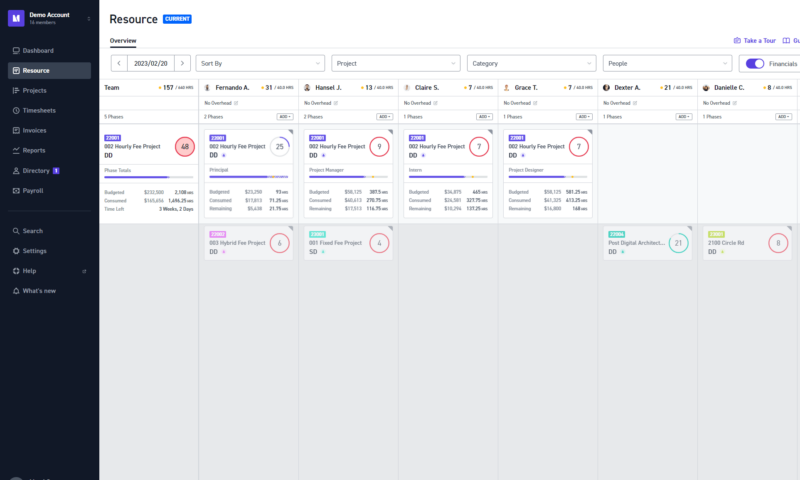
Don’t be afraid to charge a fee for changes. If the change is important, your client will pay. If not, they won’t. You may even find they stop requesting additional changes, which will help mitigate scope creep.
If you work in the architectural or construction industries, you might want to check out Monograph (here’s our Monograph review). It has powerful accounting tools that can help keep a budget under control.
Request a Change Control Process
If your project starts hurtling down a hill like a car without a driver, it might be time to implement a change control process. Instead of stakeholders coming to you willy-nilly with requests, tell the person requesting the change to file a change control. The proposal then goes before all the stakeholders, and they decide whether to approve or deny the request.
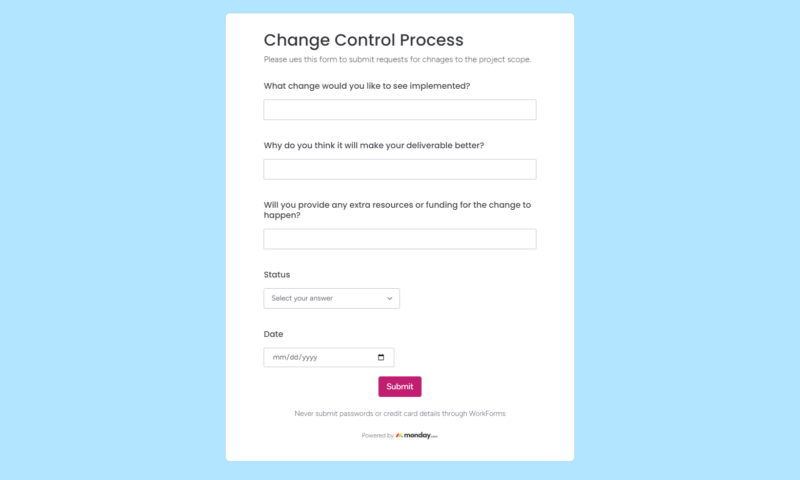
A change control process adds accountability and helps keep everyone on the same page. If you’re worried that you’re receiving too many change requests and are concerned that not all stakeholders are aware of them, a change control process will help ease your mind. You can create simple forms to help implement this in software such as monday.com. Be sure to read our monday.com review.
Learn How to Say No
It’s one of the smallest yet hardest words to say in the English language. However, it is one of the easiest ways to help prevent scope creep in project management. Standing up to a client is never easy, but it’s your job as a project manager to provide pushback to stakeholders who are crossing the line.
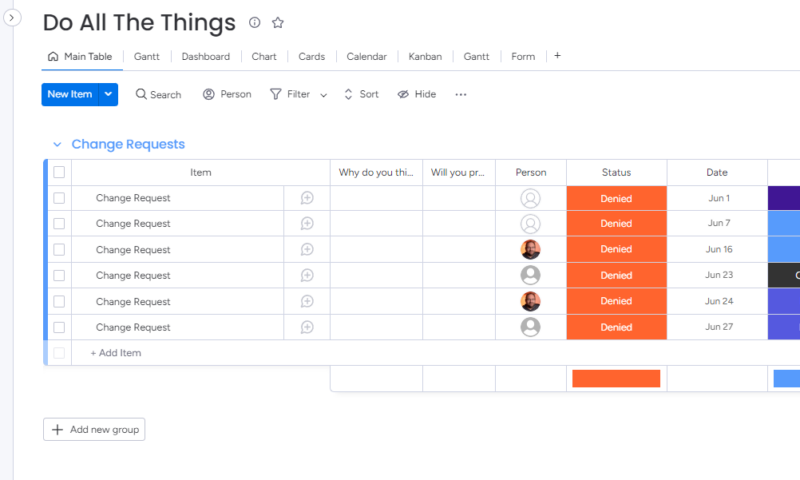
Be prepared to explain why you have said no, and provide information that shows how it will affect the entire project. If your client insists, do what we have already mentioned: Ask for an extension and a change in the budget. Don’t be afraid to communicate with stakeholders, and certainly don’t shy away from the small but mighty word “no.”
Final Thoughts: Preventing Scope Creep
We hope you never find yourself in a position where scope creep has infiltrated your project. However, if you have been or are in this position right now, we hope the information we have provided will help get you out of a bind. Be proactive and set up your projects properly from the get-go, and scope creep needn’t be an issue.
Have you ever been in charge of a project that ran into budget or scheduling issues? What did you do to resolve the problems? Have you used any of the software we mentioned to mitigate scope creep? Have you ever said no to a client? Let us know in the comment section and, as always, thanks for reading.
FAQs: Addressing Scope Creep
Scope creep can happen for various reasons, including poor planning, insufficient communication, improper resource utilization and the fear of saying no when needed.
One of the most famous examples of scope creep involved Denver International Airport. The project to build the mile-high airport was $2 billion over budget and 16 months late.
Scope creep in Agile is similar to scope creep in linear and hybrid project management methods. The extra challenge is that Agile already supports high levels of flexibility, so projects with scope creep in Agile methods can get out of hand quickly.


